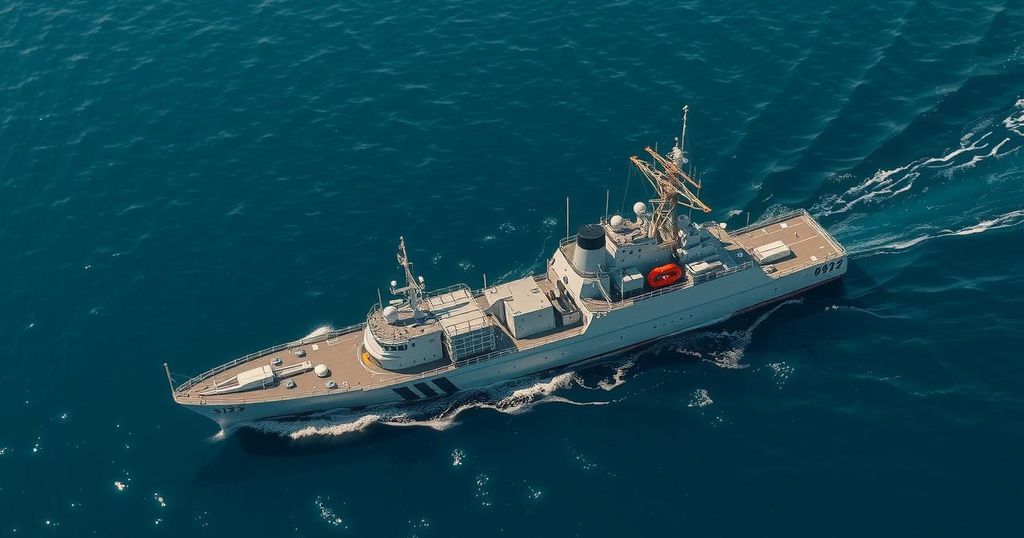Chinese Naval Activity Escalates in the Philippine Sea and Surrounding Regions
Chinese surveillance ships from the People’s Liberation Army Navy have entered the Philippine Sea after passing by Japan, with notables such as Tianshuxing (795) and Beijixing (791). Simultaneously, the CNS Liaoning aircraft carrier was reported northward in the Taiwan Strait. The U.S. and Australia conducted joint naval exercises in the Strait of Malacca, while Russian naval drills with Myanmar also concluded amid ongoing regional maritime security developments.
The People’s Liberation Army Navy (PLAN) has recently deployed Dongdiao-class surveillance ships into the Philippine Sea after traversing through Japanese waters. This movement has been officially reported by the Joint Staff Office of Japan. Concurrently, Taiwan’s Ministry of National Defense confirmed that the CNS Liaoning carrier strike group was sighted heading north through the Taiwan Strait. In the backdrop of these developments, both the United States and Australia conducted joint naval exercises in the Strait of Malacca, while Russia concluded naval drills with Myanmar on the same week. Specifically, the surveillance ship Tianshuxing (795) was tracked by the Japan Maritime Self-Defense Force while sailing 62 miles west of Amami Oshima before entering the Philippine Sea, making it the second incident involving PLAN Dongdiao ships in that region within a week. Japan’s JS Mogami (FFM-1) and an oil replenishment ship, JS Towada (AOE-422), alongside a P-3C Orion Maritime Patrol aircraft, monitored Tianshuxing during its passage. Additionally, another Dongdiao-class ship, Beijixing (791), was also observed making a similar transit. The CNS Liaoning, which recently participated in the Joint Sword-2024B exercise, sailed near Pratas Island and proceeded into the Taiwan Strait. Notably, China’s Ministry of National Defense has yet to issue any new statements regarding the Liaoning’s activities, leaving uncertainty about its next moves. Moreover, U.S. and Australian naval forces engaged in joint training exercises aimed at enhancing their interoperability and operational readiness in the Indo-Pacific region. Vice Admiral Fred Kacher of the U.S. 7th Fleet emphasized the importance of such collaborations, stating that they solidify the commitments of both nations to maintain a free and open maritime domain. Additionally, Russian naval forces concluded their Marumex 2024 exercise with Myanmar, demonstrating their intent to strengthen regional maritime cooperation against potential global threats. Subsequently, Russian destroyers returned home after a joint patrol with Chinese naval forces, highlighting ongoing military collaborations in the region.
The recent movements of Chinese naval forces in the Philippine Sea and Taiwan Strait reflect heightened tensions and evolving military strategies in the Indo-Pacific region. The presence of Dongdiao-class surveillance ships, traditionally used for intelligence gathering, signals China’s assertive stance in maritime security matters. The joint naval exercises conducted by the United States and Australia demonstrate a commitment to collective defense against increasing challenges posed by regional adversaries. Furthermore, Russia’s naval exercises with Myanmar also underscore a shared interest among nations in countering external threats and enhancing maritime security.
In summary, the maritime activities involving Chinese, American, Australian, and Russian naval forces illustrate the dynamic and often contentious nature of security in the Indo-Pacific region. The movement of Chinese surveillance ships into the Philippine Sea, coupled with the operations of the Liaoning carrier group and joint exercises by U.S. and Australian forces, highlight the strategic importance of this area. As nations continue to navigate complex geopolitical waters, their military exercises and deployments serve as both a display of strength and a message of cooperation or contention to regional rivals.
Original Source: news.usni.org








Post Comment